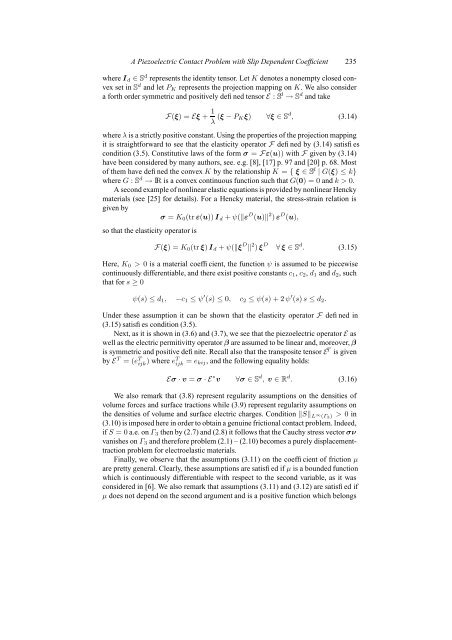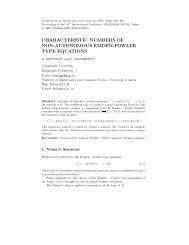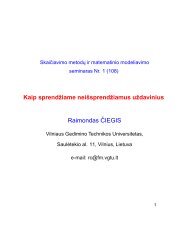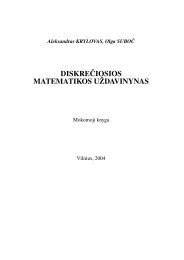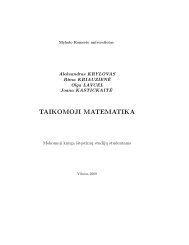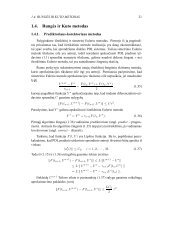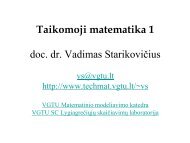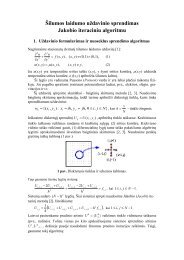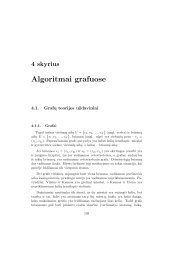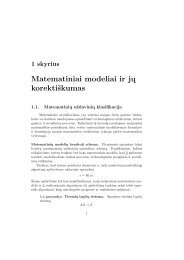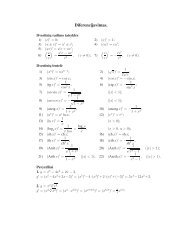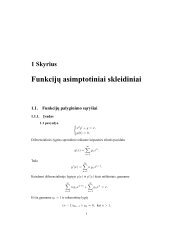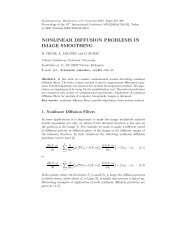a piezoelectric contact problem with slip dependent coefficient of ...
a piezoelectric contact problem with slip dependent coefficient of ...
a piezoelectric contact problem with slip dependent coefficient of ...
Create successful ePaper yourself
Turn your PDF publications into a flip-book with our unique Google optimized e-Paper software.
A Piezoelectric Contact Problem <strong>with</strong> Slip Dependent Coefficient 235where I d ∈ S d represents the identity tensor. Let K denotes a nonempty closed convexset in S d and let P K represents the projection mapping on K. We also considera forth order symmetric and positively defined tensor E : S d → S d and takeF(ξ) = Eξ + 1 λ (ξ − P Kξ) ∀ξ ∈ S d , (3.14)where λ is a strictly positive constant. Using the properties <strong>of</strong> the projection mappingit is straightforward to see that the elasticity operator F defined by (3.14) satisfiescondition (3.5). Constitutive laws <strong>of</strong> the form σ = Fε(u)) <strong>with</strong> F given by (3.14)have been considered by many authors, see. e.g. [8], [17] p. 97 and [20] p. 68. Most<strong>of</strong> them have defined the convex K by the relationship K = { ξ ∈ S d | G(ξ) ≤ k}where G : S d → IR is a convex continuous function such that G(0) = 0 and k > 0.A second example <strong>of</strong> nonlinear elastic equations is provided by nonlinear Henckymaterials (see [25] for details). For a Hencky material, the stress-strain relation isgiven byσ = K 0 (tr ε(u)) I d + ψ(‖ε D (u)‖ 2 ) ε D (u),so that the elasticity operator isF(ξ) = K 0 (tr ξ) I d + ψ(‖ξ D ‖ 2 ) ξ D ∀ ξ ∈ S d . (3.15)Here, K 0 > 0 is a material <strong>coefficient</strong>, the function ψ is assumed to be piecewisecontinuously differentiable, and there exist positive constants c 1 , c 2 , d 1 and d 2 , suchthat for s ≥ 0ψ(s) ≤ d 1 , −c 1 ≤ ψ ′ (s) ≤ 0, c 2 ≤ ψ(s) + 2 ψ ′ (s) s ≤ d 2 .Under these assumption it can be shown that the elasticity operator F defined in(3.15) satisfies condition (3.5).Next, as it is shown in (3.6) and (3.7), we see that the <strong>piezoelectric</strong> operator E aswell as the electric permitivitty operator β are assumed to be linear and, moreover, βis symmetric and positive definite. Recall also that the transposite tensor E T is givenby E T = (e T ijk ) where eT ijk = e kij, and the following equality holds:Eσ · v = σ · E ∗ v ∀σ ∈ S d , v ∈ R d . (3.16)We also remark that (3.8) represent regularity assumptions on the densities <strong>of</strong>volume forces and surface tractions while (3.9) represent regularity assumptions onthe densities <strong>of</strong> volume and surface electric charges. Condition ‖S‖ L∞ (Γ 3) > 0 in(3.10) is imposed here in order to obtain a genuine frictional <strong>contact</strong> <strong>problem</strong>. Indeed,if S = 0 a.e. on Γ 3 then by (2.7) and (2.8) it follows that the Cauchy stress vector σνvanishes on Γ 3 and therefore <strong>problem</strong> (2.1) – (2.10) becomes a purely displacementtraction<strong>problem</strong> for electroelastic materials.Finally, we observe that the assumptions (3.11) on the <strong>coefficient</strong> <strong>of</strong> friction µare pretty general. Clearly, these assumptions are satisfied if µ is a bounded functionwhich is continuously differentiable <strong>with</strong> respect to the second variable, as it wasconsidered in [6]. We also remark that assumptions (3.11) and (3.12) are satisfied ifµ does not depend on the second argument and is a positive function which belongs


